1 Production and Consumption Trends of Dryland Staples in CORAF Nations
Abstract
Sorghum, pearl millet, fonio, cowpeas, groundnuts, and livestock form the backbone of the agricultural economy in semiarid regions of West and Central Africa. This chapter presents descriptive statistics on the production, consumption, and trade of five commodities that are the mandate crops of the CORAF regional research center of excellence, Centre d’étude régional pour l’amélioration de l’adaptation à la sécheresse (CERAAS). Over the past decade, changes in the total production of these crops have been driven by land extensification at rates that are two to three times yield growth rates. While the consumption of dryland cereal crops has decreased in most nations, consistent with economic theory, evidence on groundnuts indicates increasing per capita consumption. Very limited quantities of all crops are formally traded across borders, with the exception of groundnuts, which is an important export crop in Senegal. Sorghum, pearl millet, fonio, cowpeas, and groundnuts play critical roles in the food economy of the CORAF region through the supply of calories and proteins to local populations. Strategies to increase the productivity of these crops will be beneficial in different ways to consumers and producers.
Keywords: production, consumption, trade, drylands staples, CORAF
Introduction
This chapter presents recent trends in the production, consumption, and trade of sorghum, pearl millet, fonio, cowpea, and groundnuts in 23 West and Central Africa nations covered by the West and Central African Council for Agricultural Research and Development (CORAF)1. These five crops form the basis of the food systems in many Sahelian nations in the CORAF region and are the focus of the research center of excellence, Centre d’étude régional pour l’amélioration de l’adaptation à la sécheresse (CERAAS), which has led regional efforts to increase the productivity and resiliency of these crops since 1989.
The purpose of this chapter is to provide strategic country-level information on the dynamics of these staples and consumer needs in the future. This study is restricted to sorghum, pearl millet, fonio, cowpea, and groundnuts to draw attention to the critical role these crops play in the Sahelian food system. It does not focus on the entire basket of staples available in CORAF nations. Approximately 65 million hectares of cereals and 14 million hectares of legumes were planted in CORAF countries in 2019, accounting for 63 and 51 percent of cereal and legume areas in Sub-Saharan Africa. On a global scale, CORAF nations produce approximately 27% (sorghum), 37% (pearl millet), 100% (fonio), 84% (cowpeas), and 23% (groundnuts) of the global annual production.
Overall, production of these crops has increased over the past decade, except in a few countries, and consumption has also increased. Very limited quantities of the crops are traded within the region; a limited amount of sorghum is imported from outside the region, but groundnuts are exported throughout the world. These crops, apart from groundnuts, remain relatively isolated from international markets, unlike maize or soybeans. As such, national and regional production and consumption patterns will influence local prices as international price transmission is limited (Nakelse et al., 2018). We examine each of the five crops independently through discussion and statistics on production, consumption, and trade and then provide a discussion of aggregated trends2.
Sorghum
Sorghum is harvested from over 15.8 million hectares in the CORAF region, accounting for 56% of the total area in Sub-Saharan Africa. Still, production is dominated by five countries located in the “sorghum belt”: Nigeria, Niger, Burkina Faso, Mali, and Chad. These five countries account for 89% of the regional area (Figure 1), with approximately 51% of the regional total planted in Nigeria. Niger and Burkina Faso combine to occupy only one-half the acreage in Nigeria or approximately 26% of the regional total. From 1999 to 2019, cereal area increased by 52 percent in the CORAF region, sorghum area increased by 22%, and maize by 118%. Areal expansion occurred throughout the region except for in Nigeria, Ghana, Mauritania, and the Central African Republic (Figure 2). The decline in the relative importance of sorghum in the regional cereal economy is largely panterritorial with only Niger, Guinea-Bissau, and Togo showing an increase in their share of total cereal acreage (Figure 3).
Total sorghum production increased by 1.5% per year between 1999 and 2019. Land extensification drives the increase in grain production, with the area harvested increasing by about 1% per year. The average per-hectare yield in the region is less than 1.0 mt/ha, with national differences that flow along with the differences in agroecology. However, yields have not remained stagnant, increasing at 0.9% per year on average, with several nations such as Senegal, Niger, and Cameroon exceeding a 2% annualized rate of growth in average sorghum yields. The combination of higher yields and land expansion underlines the interaction between agroecological potential and sorghum: expansion occurs in less-productive areas where the baseline potential is lower, and the gain in total production is constrained by climatic edaphic conditions interacting with other stress factors.
Sorghum consumption mirrors production patterns. Nations located in the sorghum belt consume more than 50 kg/per capita/per year, while those outside the belt consume far less (Figure 4). Overall, production estimates exceed consumption, indicating surplus grain for loss and seed. The average ratio of production to consumption is 1.75 in the region, but the ratio is lower in the sorghum belt, where the ratio is 1.43. The Chad, Niger, and Nigeria ratio is even lower at 1.13, 1.37, and 1.18, respectively.
Approximately 21,057 mt of sorghum were imported into the CORAF region in 2019, with 99% of the total volume destined for Cameroon. The United States of America was the source of this grain. The remaining tonnage consisted of cross-border trade between neighboring nations (e.g., exports from Burkina Faso into Côte d’Ivoire and Ghana or from the Central African Republic to Cameroon). Overall, the volume of cross-border trade does not exceed 7,000 mt or, in other terms, one-twentieth of 1 percent of total regional production, reinforcing the observation that sorghum is consumed in the country where it is produced. Opportunities for increased trade of sorghum from Mali will depend on a decrease in transportation costs and regional harmonization of trade policies (Kaminski et al., 2013).
Figure 1
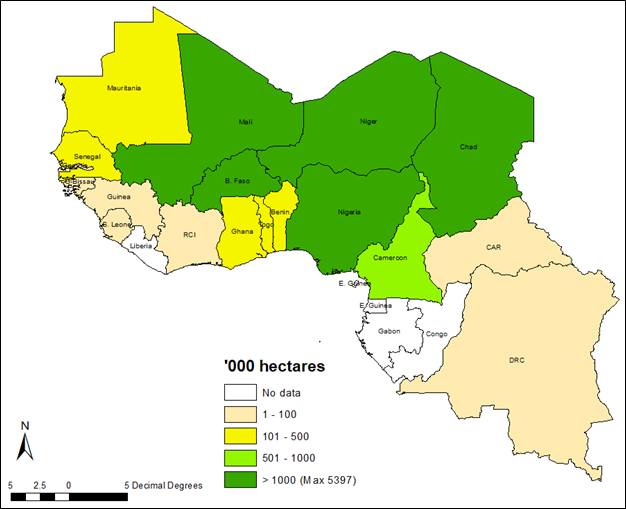
Figure 2
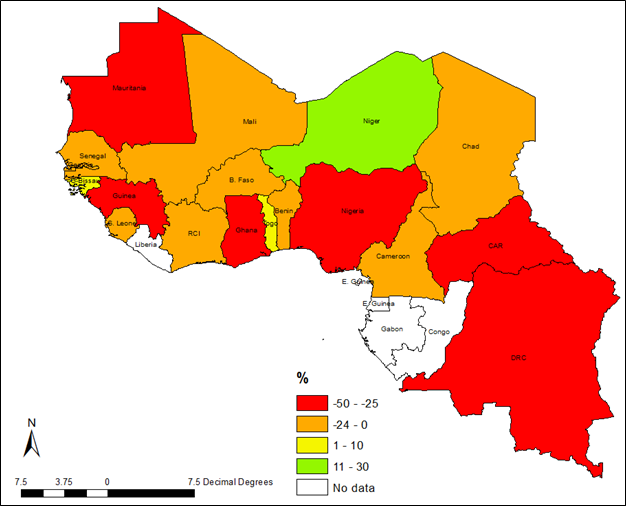
Figure 3

Figure 4
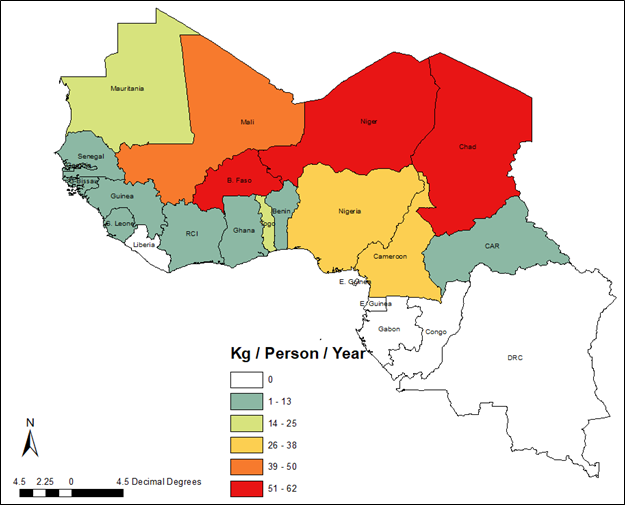
Pearl Millet
Pearl millet production spans nations from west to east in the CORAF region, but it is most intensively cultivated in the Sahelian agroecology (Figure 5). Five nations plant more than a million hectares of pearl millet annually, and Senegal is not far behind with nearly 890,000 hectares (Figure 5). Niger is an outlier among all nations and planted 6.8 million hectares of pearl millet in 2019, Nigeria planted 2.8 million, Mali 2.0 million hectares, and Burkina Faso and Chad about 1.2 million hectares each. The average regional yield is 0.851 mt/ha, and yields in Niger, Burkina Faso, Chad, and Niger are below the regional average (Figure 6).
Millet plays an important role in the cereal economy and occupies a large percentage of cereal area, especially in the dryland areas. In Niger, pearl millet is planted on 64% of all cereal area. In Senegal, it accounts for 51% of the area and about 1/3 of the area in Mali, Burkina Faso, and Chad (Figure 7). Over the past two decades, this share has decreased across the region, despite cereal area increasing, underscoring the faster increase in acreage allocated to other cereals.
Millet remains a very important staple for many nations, but few rely upon millet like Niger. Nigeriens consume an average of 124 kg/per capita/per year, which has declined from 152 kg/per capita/per year in 1999. Mali and Burkina Faso are the next highest consumers of millet but at less than half the amount consumed in Niger (61.3 and 55.6 kg/per capita/per year, respectively; Figure 8). Millet consumption is highly nation-specific, and just five nations (Niger, Nigeria, Mali, Burkina Faso, and Chad) consume 90% of all millet produced in the CORAF region (Figure 9).
International trade in pearl millet is thinner than that of sorghum. Regionally, Niger exported 5,200 mt towards Burkina Faso, accounting for 88% of the total traded volume of 6,362 mt. Trade amounts to approximately one-twentieth of one percent of regional production. Approximately 61 mt of millet were shipped off the continent towards Europe, the United States, and Japan in 2019. Cross-border flows of millet are limited by high transaction costs associated with weak farm and market logistics combined with high transportation costs (Kaminski et al., 2013). In Senegal, high social capital, represented by business networks, increased the opportunities for millet trade despite high freight costs (Jacques et al., 2018).
Figure 5

Figure 6
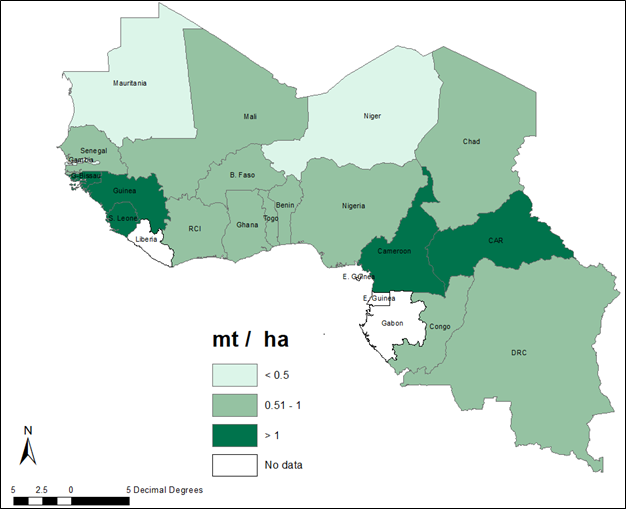
Figure 7
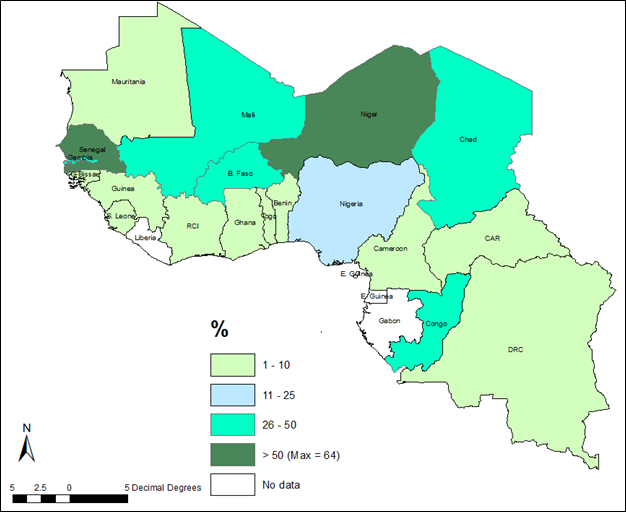
Figure 8
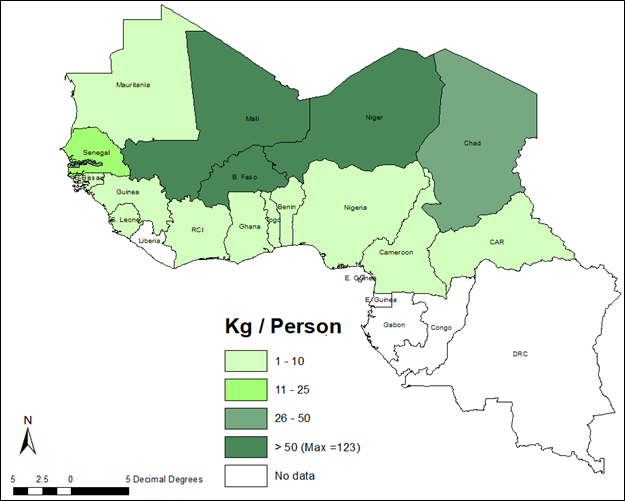
Figure 9
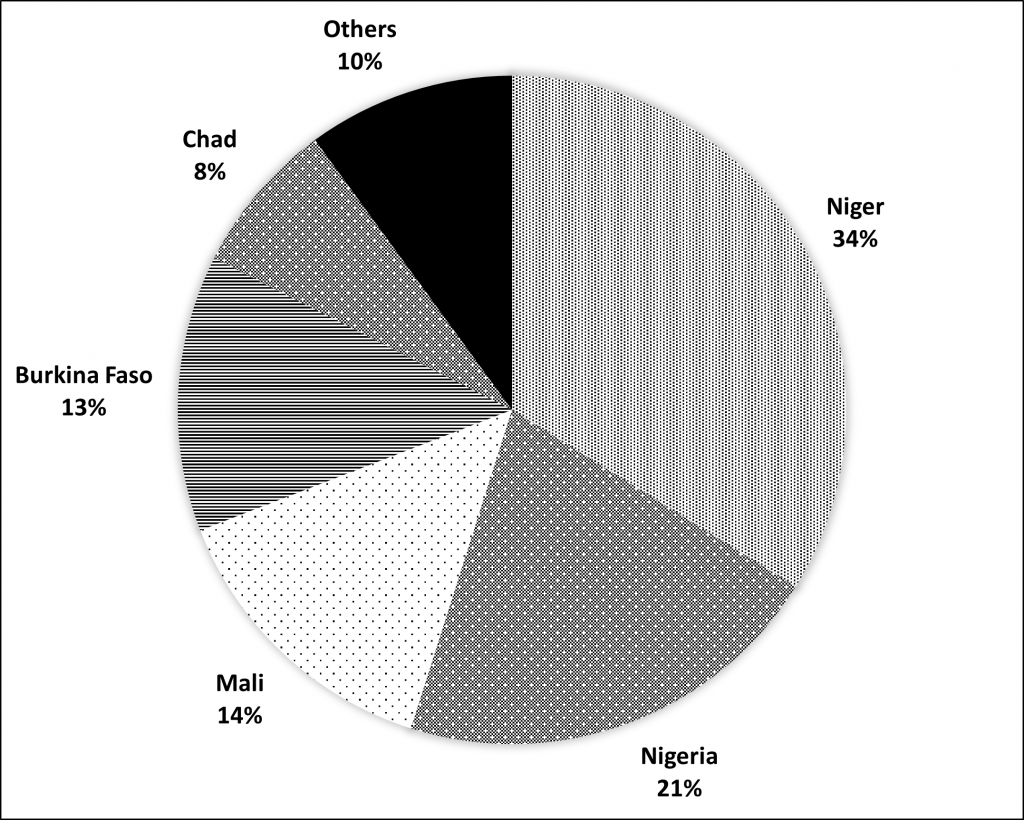
Fonio
Three countries in West Africa account for 95% of all fonio areas: Guinea, Nigeria, and Mali. Nearly 70% of all fonio area is in Guinea, and the nation produces 76% of the total regional output estimated at 701,000 mt (Figure 10). This compares to 10.4 million mt of millet and 15.6 million tons of sorghum.
There is no information on the consumption of fonio. Under the assumption that there is very little trade (as described below) and that nearly all fonio is consumed in the country in which it was produced, per capita consumption is approximately 48.7 kg/per year in Guinea. In comparison, it is less than 2.5 kg/person in all other countries. Fonio in West Africa, outside Guinea, is a specialty crop and is rarely consumed.
Nearly all international trade of fonio (355 mt of 359 mt) was exported to high-income countries in North America and Europe in 2019. Most grains were sourced in Senegal and Mali (124 and 11 mt, respectively), followed by Burkina Faso and Guinea. Like pearl millet, the trade volume of fonio is less than one-twentieth of one percent of production.
Figure 10
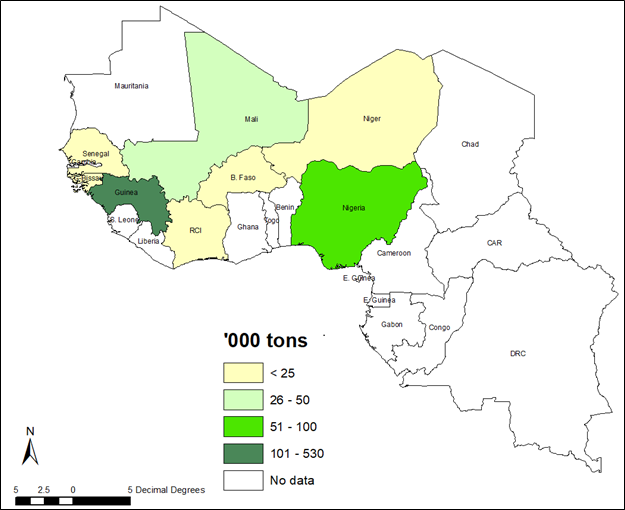
Cowpea
Cowpea, like fonio, is a highly specialized crop, and while grown in ten CORAF nations, it is concentrated in Niger, Nigeria, and Burkina Faso. These three nations account for 93% of all area planted for cowpea in the CORAF region and 82% of the planting across Sub-Saharan Africa (Figure 11). Across the region, cowpea grain production has increased 138% between 1999 and 2019, and the largest increases occurred in Niger, Burkina Faso, Senegal, and Cameroon. Across Sub-Saharan Africa, cowpea production has increased 1.5 times during the same period. There is no recorded systematic information on cowpea hay and fodder production or value despite its economic importance in the livestock sector.
The consumption of cowpea is concentrated in local production areas due to limited trade. Statistical agencies do not record the official trade of cowpeas, and these sources do not capture informal trade across border regions. Based on the production statistics and controlling for seed use and estimated losses, it is approximated that Niger, Burkina Faso, and Nigeria consume, on average, 85, 26, and 14 kg/per capita/per year in each country, respectively (Figure 12). Consumption is estimated to be below 10 kg/per capita/per year in the seven remaining countries with measured production. There are no national trade statistics on cowpea, but a few studies have examined the ex-ante impact of new cowpea technology on trade (Langyintuo & Lowenberg-DeBoer, 2006).
Figure 11
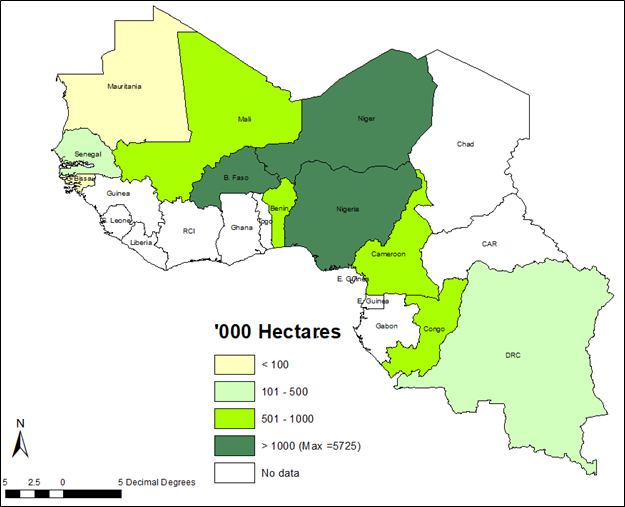
Figure 12
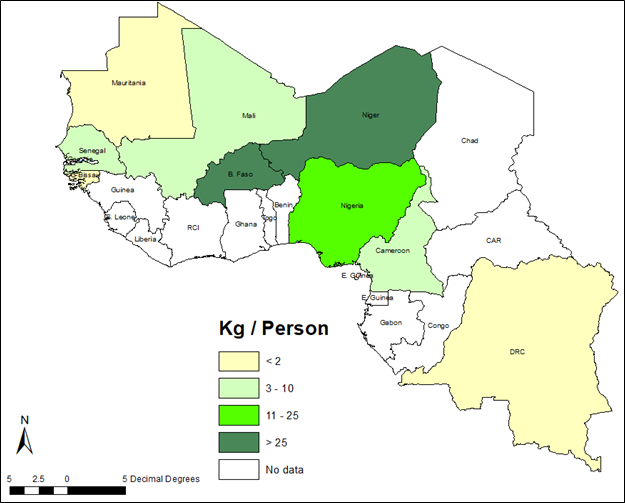
Groundnuts
Groundnut production is widespread across the CORAF region and Sub-Saharan Africa (Figure 13). Approximately 10.7 million hectares of groundnuts were planted in the CORAF region in 2019, accounting for 77% of the total area in Sub-Saharan Africa. In contrast to other crops, where very few nations accounted for 90% of planted areas, ten nations in the region account for 90% of all area and total production. These regions stretch from the western side of the region eastward into central Africa. The region produced 85% of the total output of groundnuts in Sub-Saharan Africa (Figure 14). Nearly all nations in the CORAF region have experienced an increase in the area allocated to groundnuts, resulting in an increase in production over the past twenty years. While the area harvested has increased 89% between 1999 and 2019, total production has increased by a 78%, underscoring the extensification into areas with lower production potential.
The average regional groundnut yield is 1.07 mt/ha, and this level is the highest among all Sub-Saharan African regions, but country-specific averages range between 0.53 to 1.49 mt/ha. Over time, per hectare yield has increased at approximately 0.75% per year in the region, with only four nations exceeding 1% per year (Figure 15). However, our data does not determine whether total factor productivity growth or input use is the driving factor of higher yields.
On average, 6.8 kg/per capita/per year of groundnuts are consumed in the CORAF region, but this ranges from 0.1 kg/per capita/per year in Mauritania to 17.1 kg/per year/per capita/per year in The Gambia. The nations with the greatest consumption of groundnuts include Nigeria, Niger, Burkina Faso, Cameroon, and Ghana. Combined, these nations account for 75% of the total regional consumption (Figure 16).
Trade-in groundnuts is the highest among the five crops discussed in this chapter. Approximately 2.1% of the total production volume in the CORAF region, or 236,069 mt, is traded across international borders, and 95% of the volume is sent to high- and middle-income countries outside of Sub-Saharan Africa. The leading exporter is Senegal, shipping approximately 225,304 mt, or 16% of its total national production, to fifteen countries. Exports from Senegal account for 95.4% of the total trade volume across all CORAF nations. China was the leading destination for Senegalese groundnuts and accounted for 220,877 tons or 93.6% of the total volume of regional exports. Senegal was the only nation in the CORAF region where China purchased groundnuts. The global price for groundnuts ranged from US$1,500/mt to US$2,000 during the first half of the 2020 marketing year, making it a lucrative crop for earning foreign exchange. Sector studies have highlighted strategies to increase the value of the groundnut value chain in Senegal (World Bank, 2015).
Figure 13
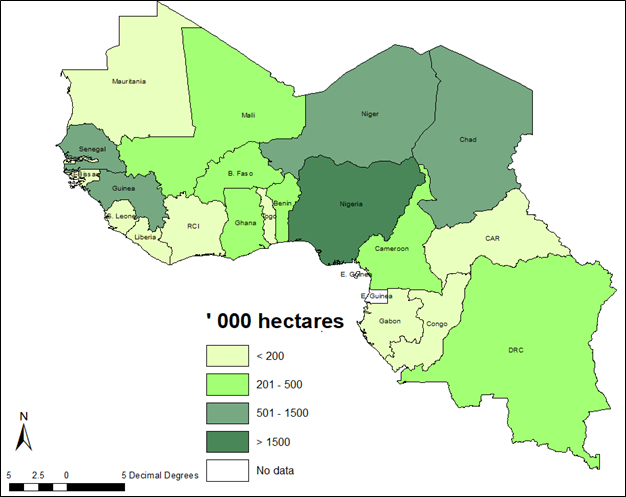
Figure 14
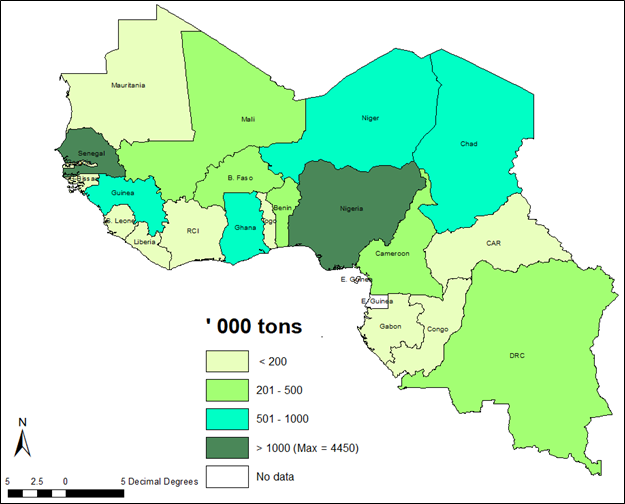
Figure 15
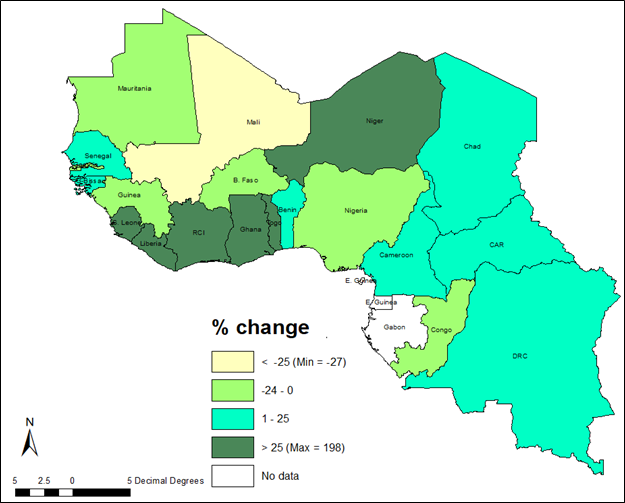
Figure 16
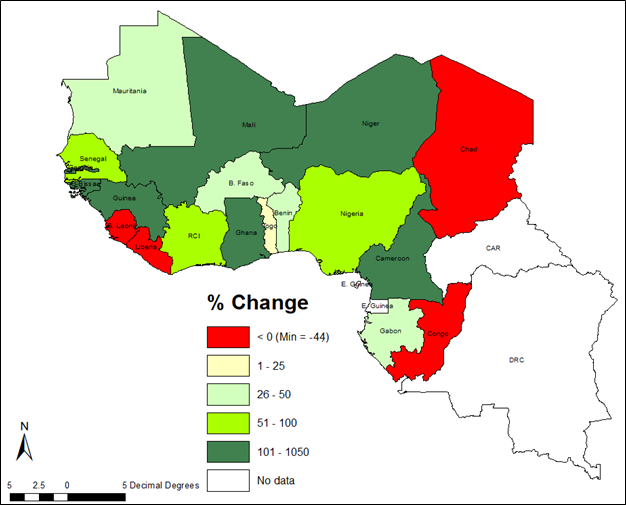
Synthesis and Projections
The previous sections have described the production, consumption, and trade of sorghum, millet, fonio, cowpeas, and groundnuts using national statistics. These statistics are pooled into crop-specific data sets to estimate trends across the CORAF region, and these trends are projected into the next decade. The data set covers the period from 1961 until 2019.
| Indicator | Sorghum | Millet | Fonio | Groundnuts | Cowpea |
| Production | 2.16 | 1.70 | 2.60 | 1.98 | 4.29 |
| Acreage | 1.42 | 1.18 | 2.20 | 1.26 | 2.60 |
| Yield | 0.59 | 0.62 | 0.72 | 0.52 | 1.85 |
| Consumption | -0.40 | -0.81 | * | 0.71 | * |
* Data does not allow an estimation of a log-linear growth rate. ** All trends are significant at 1%.
Total production of all five crops has increased between 1.7% to 4.3% per year (Table 1). Sixty to 85% of the production increase is driven by land extensification. At the same time, the yield component, a combined measure of crop varietal improvement, input intensification, and other elements of total factor productivity growth, accounts for 26% to 43% of the increase in production. The highest yield growth rate is with cowpeas, where yield growth is 2/3rds of the annual rate of areal expansion.
| 2010’s | 2010’s | 2010’s | 2010’s | ||||||
| Urban | Rural | Urban | Rural | ||||||
| Benin | 2.9% | 2.7% | Guinea | 3.1% | 3.2% | ||||
| Burkina Faso | 2.8% | 3.0% | Guinea-Bissau | 3.1% | 3.0% | ||||
| Cameroon | 2.9% | 3.0% | Liberia | 1.9% | 3.6% | ||||
| Cape Verde | -0.2% | 2.0% | Mali | 2.8% | 2.4% | ||||
| Central African Republic | 3.2% | 3.9% | Mauritania | 2.2% | 1.9% | ||||
| Chad | 4.1% | 4.1% | Niger | 2.1% | 2.4% | ||||
| Congo | 1.4% | 3.4% | Nigeria | 2.5% | 2.7% | ||||
| Cote d’Ivoire | 3.1% | 3.0% | Senegal | 2.4% | 2.2% | ||||
| DR Congo | 3.7% | 3.0% | Sierra Leone | 2.2% | 2.2% | ||||
| Gabon | -0.9% | 3.6% | Togo | 2.1% | 2.0% | ||||
| Gambia | 2.6% | 2.6% | Sao Tome and Principe | -0.9% | 3.8% | ||||
| Ghana | 2.8% | 3.0% | Average | 2.4% | 3.1% |
Source: FAOSTAT
We can estimate trends in consumption, and these trends are consistent with economic theory. Sorghum and millet are staple goods that are “inferior” to other cereals, such as wheat, rice, and maize. Over time, as income grows, consumption of these crops (on a per capita basis) decreases as food consumption diversifies into alternative staples and towards proteins, fats, fruits, and vegetables. This does not imply that the aggregate demand for these staples is decreasing. Population growth in the region remains high in many nations (Table 2). Since population growth rates are 2- to 4-times higher than the absolute value of consumption reductions, and there are more mouths to feed, demand for these crops will continue to increase. But as income grows and population growth rates stabilize, consumption of these crops as food will decrease, and alternative usages as feed or industrial products should grow.
Conclusion
Sorghum, pearl millet, fonio, cowpeas, and groundnuts, with livestock, form the backbone of the agricultural economy in semi-arid regions of West and Central Africa. This chapter aimed to explore the graphical distribution of these crops in the region, their productivity and consumption through national averages, and changes over time. The national maps oversimplify the distribution of the crops in the region because the data do not provide resolution to be displayed on a finer scale where agroecological, edaphic, and other constraints can be correlated with outcomes.
Over the past twenty years, cropland has expanded in the CORAF region, but the area allocated to sorghum, millet, and fonio increased more slowly than other crops. Overall changes in the total production of these crops have been driven by land extensification at rates two to three times the growth rate in yields. The consumption of dryland cereal crops has decreased in most nations, consistent with economic theory, while evidence on groundnuts indicates increasing per capita consumption. We do not have data on fonio or cowpea consumption.
There is very limited information on the trade of the five commodities in the region, apart from groundnuts and cowpea (Jacques et al., 2018; Kaminski et al., 2013; Langyintuo & Lowenberg-DeBoer, 2006). Groundnuts have served as an important income-generating crop for farmers in Senegal since the colonial period, and evidence indicates that this is correlated with an increase in consumption (World Bank, 2017). The lack of trade data implies that most production is locally consumed or saved for seed. Future research on regional trade may look to novel data sets that collect information from border crossings where informal exchange occurs.
Sorghum, pearl millet, fonio, cowpeas, and groundnuts play critical roles in the food economy of the CORAF region through the supply of calories and protein to local populations. Strategies to increase the productivity of these three crops will be beneficial in different ways. Increased productivity will accelerate a decline in the share of area allocated to these crops without increased trade or new market opportunities for sorghum and pearl millet. It may also spur innovative food products to meet consumer needs. This will free land to be allocated to other cereals, legumes, or high-valued crops with higher returns to land and labor. In the case of dryland crops in the CORAF region, this is likely to include cowpeas and groundnuts.
References
Jacques, D. C., Marinho, E., D’Andrimont, R., Waldner, F., Radoux, J., Gaspart, F., & Defourny, P. (2018). Social capital and transaction costs in millet markets. Helion, 4(1), 1–25.
Kaminski, J., Elbehri, A., & Samake, M. (2013). An assessment of sorghum and millet in Mali and implications for competitive and inclusive value chains. In FAO/ IFAD (Ed.), Rebuilding West Africa’s food potential (pp. 481–501).
Langyintuo, A. S., & Lowenberg-DeBoer, J. (2006). Potential regional trade implications of adopting bt cowpea in West and Central Africa. AgBioForum, 9(2), 111–120.
Nakelse, T., Dalton, T. J., Hendricks, N., & Hodjo, M. (2018). Are smallholder farmers better or worse off from an increase in the international price of cereals? Food Policy.78, 213–223.
World Bank. (2015). Etude diagnostique de la chaîne de valeurs arachide au Sénégal. World Bank.
World Bank. (2017). Groundnut value chain competitiveness and prospects for development: Final report. World Bank.

